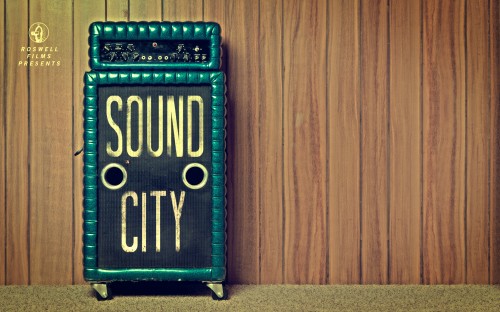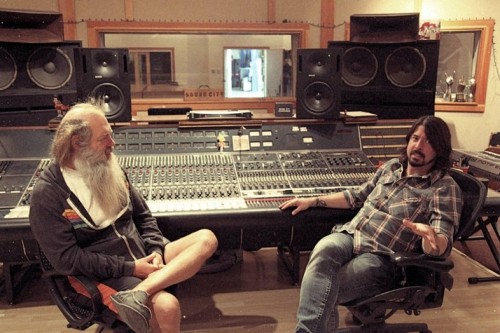
 I wasn’t really old enough to get into Nirvana, but I did catch the Foo Fighters wave. So when I heard that Dave Grohl—who was the drummer for Nirvana & the lead vocalist and multi-instrumentalist for Foo Fighters—was making a documentary on Sound City Studios—along with an accompanying soundtrack of new material by the people that made some of the most iconic rock records at that studio—I became extremely excited. The documentary itself contains no frills and is straightforward, a lot like the nature of the studio and the people who worked in it. Well worth the watch for a fine piece of rock ’n’ roll history and contains interviews with some of the greats in the world of rock.
I wasn’t really old enough to get into Nirvana, but I did catch the Foo Fighters wave. So when I heard that Dave Grohl—who was the drummer for Nirvana & the lead vocalist and multi-instrumentalist for Foo Fighters—was making a documentary on Sound City Studios—along with an accompanying soundtrack of new material by the people that made some of the most iconic rock records at that studio—I became extremely excited. The documentary itself contains no frills and is straightforward, a lot like the nature of the studio and the people who worked in it. Well worth the watch for a fine piece of rock ’n’ roll history and contains interviews with some of the greats in the world of rock.
Much of the documentary focuses, though, on Sound City’s exclusive use of the Neve 8028 console which is a hand-wired analog mixing console that recorded tracks on tape and relied on a human splicer to edit each take. Along with this focus was a general venture into the various records recorded at the studio. However, it isn’t until the final quarter of the documentary—while they document the recording of the “soundtrack” that was to accompany the film—that the profundity hits fever pitch. During the filming of one recording session with Paul McCartney, Grohl, Krist Novoselic and Pat Smear, there is this discussion incorporating interviews with James Brown, a producer for the record, and Dave Grohl about the nature of working with the Neve 8028 which helps encourage and shape creative activity:
James Brown: “The limitations of this [Neve 8028], it forces you to make decisions on… based on what’s most important to translating that song…”
Dave Grohl: “One of the things I think that makes good music is some sort of…restrictions…”
James Brown: “…that’s where 24-track mentality comes in. You commit to what it is. With Pro Tools, you can always come back to it; you could change it and add to it to try to make it work, you know, cuz your not being forced to make choices…creative ones.”
 When I got to this part of the documentary, I was just struck by their comments. Neither one considered creativity something that could be nurtured well within the modernist (dare I say, American or Western) understandings of freedom—full autonomy to do what one wants when one wants to do it without restrictions. Both Brown and Grohl note the need for constraints in the making of good “human” music. Most of the language used in expressing the sound that the Neve 8028 recorded revolved around music “sounding like people” or people, humanly, interacting with each other. Not perfect, but just right.
When I got to this part of the documentary, I was just struck by their comments. Neither one considered creativity something that could be nurtured well within the modernist (dare I say, American or Western) understandings of freedom—full autonomy to do what one wants when one wants to do it without restrictions. Both Brown and Grohl note the need for constraints in the making of good “human” music. Most of the language used in expressing the sound that the Neve 8028 recorded revolved around music “sounding like people” or people, humanly, interacting with each other. Not perfect, but just right.
In a separate interview for NPR, Grohl clarifies how the Neve 8028 works and the benefits of the sound processed:
“It’s like a big stereo. You take a microphone and you plug it into the console. You sing into the microphone, the sound goes through the cable, into the desk. And in the desk, you can manipulate the sound by making it brighter, giving it more bass, basically like an EQ on your stereo. Then the sound comes out of the desk and into your tape machine or your Pro Tools unit, and then that’s the sound that you get…It doesn’t change the performance but it does enhance the way that it sounds. You know, it’s the difference between listening to an old record on an old stereo versus listening to something off of your iPod. It really suits rock ‘n’ roll. I think musicians like me are drawn to those older desks, not just because they’re legend and lore but also because they do something really specific that is hard to emulate or re-create digitally.” – “Dave Grohl Finds Music’s Human Element — In A Machine”
 According to Grohl, in a world where digital technology is the wave of the future, it is still not able to do everything and reproduce all sounds like advertised. In a strictly Pro Tools context, the theoretical field of options is open for the musician to do what they like how they like. This open-ended ‘freedom’ lends itself, according to various parts of the documentary, to the ability for musicians to sell themselves even though their actual talent does not match the produced and processed sound on the actual track. With the Neve 8028, there are limitations on what can be nipped and tucked even when patched in through Pro Tools. The musical information that goes into the program or tape is still raw and ‘human’–not at all perfect–and forces hard decisions about how the song would best be translated. Rather than inhibit creativity, in other words, this console appears to enhance it, at least if Grohl and co are to be trusted
According to Grohl, in a world where digital technology is the wave of the future, it is still not able to do everything and reproduce all sounds like advertised. In a strictly Pro Tools context, the theoretical field of options is open for the musician to do what they like how they like. This open-ended ‘freedom’ lends itself, according to various parts of the documentary, to the ability for musicians to sell themselves even though their actual talent does not match the produced and processed sound on the actual track. With the Neve 8028, there are limitations on what can be nipped and tucked even when patched in through Pro Tools. The musical information that goes into the program or tape is still raw and ‘human’–not at all perfect–and forces hard decisions about how the song would best be translated. Rather than inhibit creativity, in other words, this console appears to enhance it, at least if Grohl and co are to be trusted
The creative contours that are produced from a more constrained context or medium presented by the analogy of the Neve 8028 reverberate into a multitude of areas of everyday life and culture. You can see a similar dynamic at work in consumer studies, e.g. this NY Times article from 2010. You can even see it expressed in the world of network television with shows like Seinfeld, as our own David Zahl has tried to show:
Yet to my ears and eyes, Seinfeld transcends whatever ethos might have informed it. That is, the gags are that clever, the characterizations that inspired, the honesty that unflinching, the catch phrases that silly – these factors (plus many others) make Seinfeld an inadvertent but no less shining testament to human creativity and wit, not to mention the subversive potential of the 21 minute situational comedy…That brief half hour is all it takes for our walls come down, and with defenses lowered, who knows what might happen! – “A Breakout Session About Nothing: Everything I Never Learned From Seinfeld”
Seinfeld, on the surface, should have been a show that fit more in the confines of the likes of HBO or Showtime where there were fewer TV guidelines to follow and fewer restrictions on what content could be presented—in other words, it should have been the 90s version of Curb Your Enthusiasm. However, it is precisely the challenge presented by those limitations of network TV and those restrictions on content that forced the hand of the writers to be more clever and subtle in approaching the content and gags. To the point where plenty of people would make the case that Seinfeld is, in fact, the better show even though both came from the same mind. I know that is often my own conclusion on the matter.

The analogy even works its way into theological considerations as well. Take our understanding of the nature of scripture and how it is interpreted might benefit from the Neve 8028 analogy. If we come to the text with a more Reformational understanding, for instance, as ‘God-breathed’ and therefore bigger and more authoritative than we are, then we would be coming to the text with unique constraints that might actually lend the reading a deeper resonance. On the other hand, more open-ended anything-goes frameworks might actually keep the reader at bay rather than draw them in. Within a Neve 8028 understanding of freedom and creativity, the absence of restriction may lend itself to interpretive convenience instead of soulful engagement.
Whatever the case, Grohl’s and Brown’s observations present a compelling picture of the tyranny—or paralyzing nature—of freedom conceived as pure unadulterated autonomy. It all just goes to show that the “music of freedom” (as Salmon Rushdie famously termed rock ‘n’ roll) may have found its creativity in something that perhaps looked less like the open road and more like an analog mixing console.
[youtube=http://www.youtube.com/watch?v=HQoOfiLz1G4&w=600]

COMMENTS
4 responses to “The Neve 8028: Shaping the Contours of Creativity and Freedom Since 1973”
Leave a Reply













Sound City in the second half is quite possibly the most pompous self-righteous documentary I’ve seen in a while. The musicians involved pretty much discredit ALL dance/electronic, hip-hop, r&b, and modern pop music in one sweep. Rockist elitism at its finest. I actually said out loud in the theater “you’ve got to be kidding me!” when Grohl or one of the other musicians said “Real men record on this Neve soundboard”. The notion portrayed in the movie that all music not recorded in a studio on an expensive soundboard is “trash” is completely absurd. Pro Tools and other cheaper music computer software have made recording accessible to many other artists that might not have the budget of a multi million major label deal. Cheaper recording tools have in many ways given the less fortunate an outlet to express themselves artistically. Seems to me a closer representation of the gospel of Christ to the lesser of these!
I actually did find some of the same quotes from the musicians to be elitist and heavily weighted towards rock music. So I do agree with your criticism of that aspect of it and, in no way, was I denigrating some truly creative new digital technology which has given opportunity to people that probably didn’t have those opportunities before. However, I think some of the critiques of a Pro-Tools musical culture, in the realm of creativity and freedom, still stand fairly strong, regardless of some of the elitist comments made. I, too, love electronic, hip/hop, etc. I believe it is truly music in every sense of the word. Which is why I found Trent Rezner’s presence in the film in the midst of “the most pompous self-righteous” part of the documentary to be rather strange considering he relies heavily on the new digital technology. I think he is a good representation of a balance, someone who understands the creativity that restraints inherent in older technology can develop while not discounting the musicality of newer digital technology. Matter of fact, in the documentary, he states that very fact, that new technology can be very musical if used creatively and not as a crutch (which I think can often be a fair critique of much use of newer digital technology).
All that being said, I totally get your criticism and I do agree with you that elitism reared its ugly head in several parts of the documentary. However, proponents of the digital technology run the risk of being pompous and self-righteous as well. This documentary still didn’t reach the heights of pomposity and self-righteousness that Steve Albini reached in Copyright Criminals…
I spent some great time in that studio around 1980 working with a close friend on his funk/rock/pop album that had a good deal of jazz influence within it. That studio was VERY special. I can’t imagine a genre that wouldn’t benefit from it and that glorious Neve board. Listening back to takes…. you could practically break your face with your own smile. Now that I’m in Nashville, the closest I’ve experienced to that is Ocean Way that also have a large vintage Neve. (oh, recorded fusion jazz audio/video there, not rock by the way)
I played a Washburn AV5 guitar through a Boss
Distortion pedal, the orange one, and ran that into an Emerson jam box from 1980 with a dual cassette
Tape player and a mic mixing knob. That’s how
Elite I was in the early 80s.